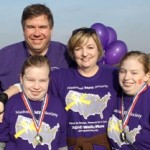
Success Stories

2014 - Bryant Graeber, face of Harris Y, greets millionth guest
Testimonials
If it weren't for the scientists, physicians and facilities who work tirelessly pursuing even the tiniest clues that may lead to a cure for an orphan disease, the Ryan Foundation would never be able to help families find the hope they need. Here's what a few of them have to say about the impact the Ryan Foundation has made on their inspiring work.
Patients

Mark and Jeanne Dant and the Ryan Foundation had the vision to provide funding to Dr. Emil Kakkis, which eventually led to the approval of the first enzyme replacement therapy for an MPS disease, MPS I. Over the years the Ryan Foundation has continued to fund pivotal MPS research and support legislation to improve the lives of individuals impacted by these diseases. Children and adults with MPS and other lysosomal diseases throughout the world have benefited from the commitment of the Ryan Foundation.
Melissa Bryant
MPS1 Parent

Our lives were forever changed in 1998 when my son, Bryant, received his first Aldurazyme treatment for MPS 1.
He was diagnosed with MPS 1 when he was 6 years old. This news was devastating to our family. We didn't know what the future would hold - but refused to give up hope. Years passed. Bryant's health declined.
Enter The Ryan Foundation. This amazing foundation and the Dant family partnered with Dr. Emil Kakkis, enabling the development of an effective drug and a successful clinical trial. Without the Ryan Foundation, it would have taken many more years to bring this drug to the market - and many more years for children to be able to receive treatment.
The battle is far from over. While the weekly infusions have changed Bryant's life in so many positive ways, there is more work to be done. Additional funds are greatly needed to address many other issues, and to help many with other orphan diseases. I will always be eternally grateful to the Ryan Foundation for their dedicated work and relentless pursuit of answers and solutions. Continued funding and donations are critical in the need to forge ahead with more research, treatments and success stories.
1998. A banner year for our family. Thanks to The Ryan Foundation and Dr. Emil Kakkis. Keep up the oustanding work.
Stephen E. Holland
MPS 1 Dad

To Past, Current, and Future Supporters of the Ryan Foundation,
My name is Steve Holland, and I want to share my family’s experiences with the Ryan Foundation. I first became aware of the Ryan Foundation shortly after my three children, Spencer, Madison, and Laynie, were diagnosed with MPS 1 in 1994. We met Mark, Jeanne, and Ryan Dant at our first MPS conference that same year and were immediately impressed with their passion to improve the lives of children with MPS. Also living in Texas, we were able to interact with them occasionally and help with the Ryan Foundation fundraisers over the years. Then in 1998, Spencer was able to participate in Emil Kakki’s first clinical trial for Aldurazyme thanks to the support the study received from the Ryan Foundation.
Maddie and Laynie were able to participate in the second clinical trial for Aldurazyme that began in 2000. The health of all three kids improved greatly after receiving Aldurazyme and we participated in the FDA panel hearing along with the Dants that resulted in the approval of Aldurazyme in 2003. Since then, enzyme replacement therapies for two other MPS diseases have been approved and a third is on the verge of approval. All of this was made possible because of the initial funding from the Ryan Foundation. So, not only did it improve my children’s lives, it has drastically improved the lives of literally thousands of children across the globe and continues to do so until this day.
Sadly, my brave son’s battle against MPS ended in 2008 with his untimely death. However, Maddie and Laynie continue the fight and are participating in an intrathecal enzyme replacement therapy trial to try to stop the degenerative affects of MPS on their brain and cognition. Again, the Ryan Foundation has been a critical funder of the study based out of UCLA and the University of Minnesota. Among other things, it has provided necessary travel funds to enable us to travel to California and Minnesota so that our girls can participate in the study.
In addition to being an MPS dad, I serve on the National MPS Society’s Board of Directors, currently serving as President. In that role, I want you to understand the high esteem our Board of Directors and all of our member families have for the Ryan Foundation. The Ryan Foundation is seen as the premier MPS 1 research foundation and the pioneer that developed enzyme replacement therapy that has so greatly benefited all of their kids.
If you are a past or current contributor to the Ryan Foundation, think you! If you are considering donating, please give it serious consideration as we are seeing tangible results from the Ryan Foundation’s efforts!
Researchers

The Ryan Foundation has generously supported our research at the University of Minnesota exploring the abnormalities in brain structure and function in MPS disorders. In addition, they have supported our efforts to understand the relationship of brain abnormalities to genetic mutations. They are now supporting the establishment of a typically developing MRI control group of very young children to better understand the brain in MPS disorders.
The Ryan Foundation support has provided the pilot work that led to government funding of this work. They provided support for the development of new and sensitive methods of monitoring brain-related treatment outcomes. Altogether, their research grants have allowed us to make substantial progress in the scientific understanding of the brain processes that underlie MPS disorders. We are grateful for their unfailing generosity.
Patricia Dickson, M.D.
Associate Professor
, Department of Pediatrics
, Chief, Division of Medical Genetics
Los Angeles Biomedical Research Institute at
Harbor-UCLA Medical Center

What the Ryan Foundation has achieved is nothing less than extraordinary. The enzyme replacement therapy that Emil Kakkis developed would never have happened without the Foundation’s support, and children’s lives are absolutely saved every day by this treatment.
The brain is the next challenge. Our lab here at LA BioMed has achieved much on that front due directly to Ryan Foundation support:
We showed that enzyme given into the brain can get where it needs to go to treat disease. It was generally thought that there was no way for a protein as big as an enzyme to get into the brain from the spinal fluid. Our paper, published in 2007 and funded by the Ryan Foundation, showed that this was indeed possible. It was in many ways a revolution in the field of neurotherapeutics.
We conducted the first clinical trial of brain-directed enzyme for any of the MPS disorders. Because of our studies, which the Foundation made possible, we were granted the first trial by the Food and Drug Administration to give enzyme therapy into the spinal fluid for MPS type I. The FDA even awarded us a grant to help pay for our research.
We opened the door for others to develop therapies that will help children afflicted by genetic disease. Our study has become the template for clinical trials for MPS II and IIIA, as well as planned studies for other lysosomal disorders. The study has also influenced people outside of the lysosomal and MPS disease community. For example, I have helped Isis Pharmaceuticals as they seek to develop spinal fluid treatments for spinal muscular atrophy, and have given talks for drug delivery workshops and the memory and aging center at UCSF. Our work was even cited by a research group developing treatments for organophosphate intoxication.
We proved that early treatment can prevent most MPS disease. There were some people who claimed that enzyme therapy couldn’t treat the bones and heart, and that there was no proof that early treatment was necessary. We proved them wrong in a landmark study published in 2010 in Science Translational Medicine. This is important because it means that screening newborns at birth can save more lives. A test is in the development stage in the state of Washington.
We showed that the immune response to enzyme therapy is still a challenge, and that we can improve people’s lives if we can address this challenge.
We have recently shown that brain-directed enzyme therapy can improve neuroimaging findings in MPS I dogs. Using advanced neuroimaging techniques, we showed that a structure in the brain, the corpus callosum, shows loss of volume in MPS I that is prevented with intrathecal enzyme replacement therapy. Our colleagues in Minneapolis have seen the same volume loss in people affected by MPS I.
In terms of the present, the Ryan Foundation support is paying for transportation for MPS I families to our clinical trial of intrathecal enzyme replacement therapy. We would absolutely not be able to conduct this research without travel support. Families come to our study from Florida, New York, Alaska, Pennsylvania and elsewhere. The travel has pleasant side effects too – for some of these families, just coming to California means so much to them.
While our lab is now funded by other sources (NIH, the National MPS Society and CIRM, the California stem cells initiative), we owe our existence to the Ryan Foundation. We continue to work to solve the problems facing people with MPS I. The three biggest problems are treatment of the brain, reducing the immune response to enzyme therapy, and treating hard-to-treat physical disease like the bones and heart. For brain disease, we are working on ways to quantify the response in the brain using advanced neuroimaging techniques. Our corpus callosum finding represents a potential surrogate marker for clinical trials – so that we can create a path for faster and better clinical trials leading to approvals for brain treatments. We have projects evaluating the immune response to enzyme treatment, and have shown that early treatment will prevent most disease in the bones and heart. Our past support from the Ryan Foundation has allowed us to lead the MPS I field in all of these areas.
I want to say thank you. Your support has changed lives in ways you can’t begin to imagine. The impact of the research that you have funded is still spreading throughout the scientific community. Finally, I want the Foundation to know that the research we continue to perform in the lab stems directly from the support that the Ryan Foundation provided. I don’t know what the future will bring, but I do know that we will be part of it, fighting for kids with MPS I.